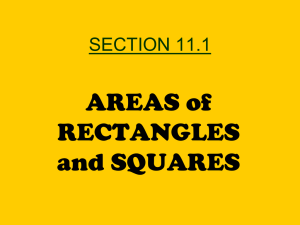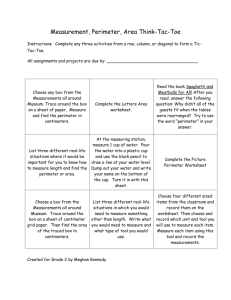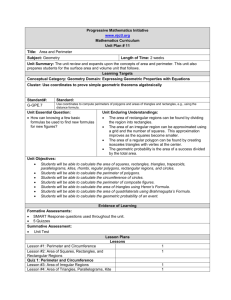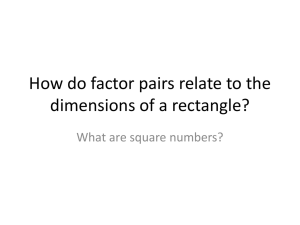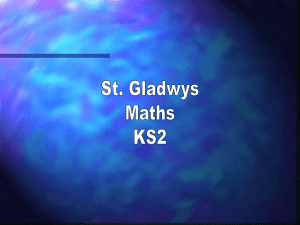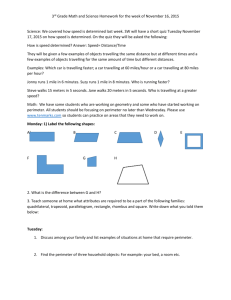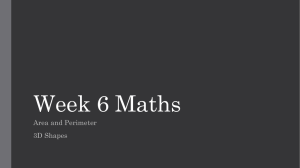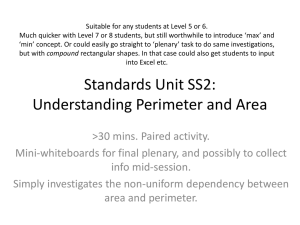Parent Overview: Area and Perimeter
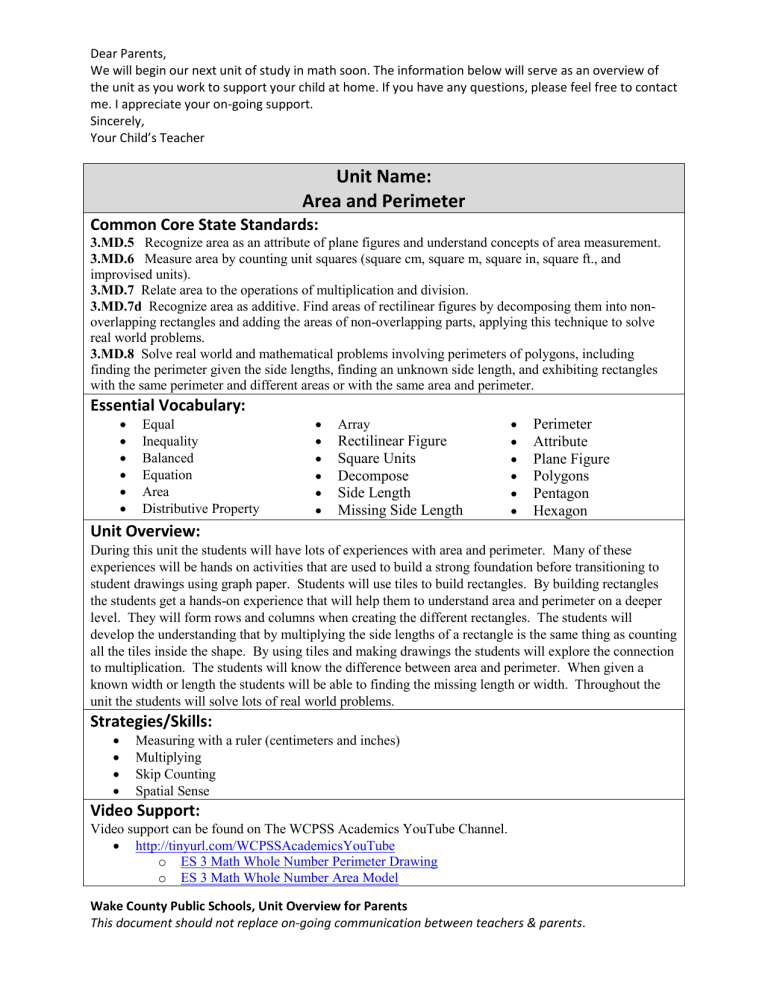
Dear Parents,
We will begin our next unit of study in math soon. The information below will serve as an overview of the unit as you work to support your child at home. If you have any questions, please feel free to contact me. I appreciate your on-going support.
Sincerely,
Your Child’s Teacher
Unit Name:
Area and Perimeter
Common Core State Standards:
3.MD.5
Recognize area as an attribute of plane figures and understand concepts of area measurement.
3.MD.6
Measure area by counting unit squares (square cm, square m, square in, square ft., and improvised units).
3.MD.7
Relate area to the operations of multiplication and division.
3.MD.7d
Recognize area as additive. Find areas of rectilinear figures by decomposing them into nonoverlapping rectangles and adding the areas of non-overlapping parts, applying this technique to solve real world problems.
3.MD.8 Solve real world and mathematical problems involving perimeters of polygons, including finding the perimeter given the side lengths, finding an unknown side length, and exhibiting rectangles with the same perimeter and different areas or with the same area and perimeter.
Essential Vocabulary:
Equal
Inequality
Balanced
Equation
Area
Distributive Property
Array
Rectilinear Figure
Square Units
Decompose
Side Length
Missing Side Length
Perimeter
Attribute
Plane Figure
Polygons
Pentagon
Hexagon
Unit Overview:
During this unit the students will have lots of experiences with area and perimeter. Many of these experiences will be hands on activities that are used to build a strong foundation before transitioning to student drawings using graph paper. Students will use tiles to build rectangles. By building rectangles the students get a hands-on experience that will help them to understand area and perimeter on a deeper level. They will form rows and columns when creating the different rectangles. The students will develop the understanding that by multiplying the side lengths of a rectangle is the same thing as counting all the tiles inside the shape. By using tiles and making drawings the students will explore the connection to multiplication. The students will know the difference between area and perimeter. When given a known width or length the students will be able to finding the missing length or width. Throughout the unit the students will solve lots of real world problems.
Strategies/Skills:
Measuring with a ruler (centimeters and inches)
Multiplying
Skip Counting
Spatial Sense
Video Support:
Video support can be found on The WCPSS Academics YouTube Channel.
http://tinyurl.com/WCPSSAcademicsYouTube o ES 3 Math Whole Number Perimeter Drawing o ES 3 Math Whole Number Area Model
Wake County Public Schools, Unit Overview for Parents
This document should not replace on-going communication between teachers & parents.
Dear Parents,
We will begin our next unit of study in math soon. The information below will serve as an overview of the unit as you work to support your child at home. If you have any questions, please feel free to contact me. I appreciate your on-going support.
Sincerely,
Your Child’s Teacher
Video support can be found on Learn Zillion
https://learnzillion.com
o cover-the-area-of-a-shape-using-square-units o find-the-area-of-a-shape-using-square-units o use-equal-square-units-to-find-the-area o find-the-area-of-a-square-or-rectangle-by-counting-unit-squares o determine-which-unit-of-measurement-to-use-to-find-the-area o find-the-area-of-a-shape-using-a-key-to-find-the-unit-of-measure o find-the-area-of-a-rectangle-using-an-array o find-the-area-of-a-rectangle-by-multiplying-side-lengths o find-missing-side-lengths-by-drawing-arrays o given-the-area-find-missing-side-lengths-of-a-rectangle o find-the-perimeter-of-a-polygon o find-the-perimeter-of-a-square-or-rectangle-by-adding-side-lengths o find-the-perimeter-of-a-polygon-in-real-world-problems o find-perimeter-with-missing-side-lengths
Additional Resources:
If you have limited/no internet access, please contact your child’s teacher for hard copies of the resources listed in this document.
NCDPI Unpacking Document: 3 rd Grade Unpacking Document
Wake County Public Schools, Unit Overview for Parents
This document should not replace on-going communication between teachers & parents.
